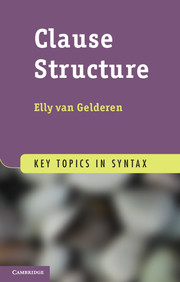3 - The VP-Layer
Published online by Cambridge University Press: 05 June 2013
Summary
In this chapter, we examine the layer that represents argument and event structure. The central question is how to map the arguments onto the syntactic structure. When thematic structure is first introduced into generative syntax in the late 1970s, it is projectionist: the lexical item (usually the verb) determines the argument structure of the clause. This is also known as a lexicalist approach. In the early 1990s, the verb is seen as composed of smaller events, and the structure around the verb comes to be seen as playing a major role in thematic/argument structure. This approach is known as constructionist. Structurally, the information on the aspect and the definiteness of the arguments is represented by a double VP, known as the VP-shell.
At the moment, both projectionist and constructionist views are important in the literature. The position argued for in this chapter is that both the information about the verb in the lexicon and structure added from the outside play a role. The crucial problem for both approaches is how we derive the hierarchical order of arguments.
Section 3.1 reviews some of the developments in representing argument structure from the early 1980s to the present. Unergative, unaccusative, and transitive verbs are discussed in Section 3.2. Sections 3.3 and 3.4 discuss alternations, the inchoative/causative alternation and “double object” one, respectively. Section 3.5 looks at aspect and the event structure. Section 3.6 includes some remarks on cross-linguistic variation and on acquisition. In Section 3.7, I end by comparing the lexicalist and constructionist approaches and also by tying argument structure to the main topic of the book, namely how a feature-based approach and constructionist approach work together.
- Type
- Chapter
- Information
- Clause Structure , pp. 75 - 114Publisher: Cambridge University PressPrint publication year: 2013

